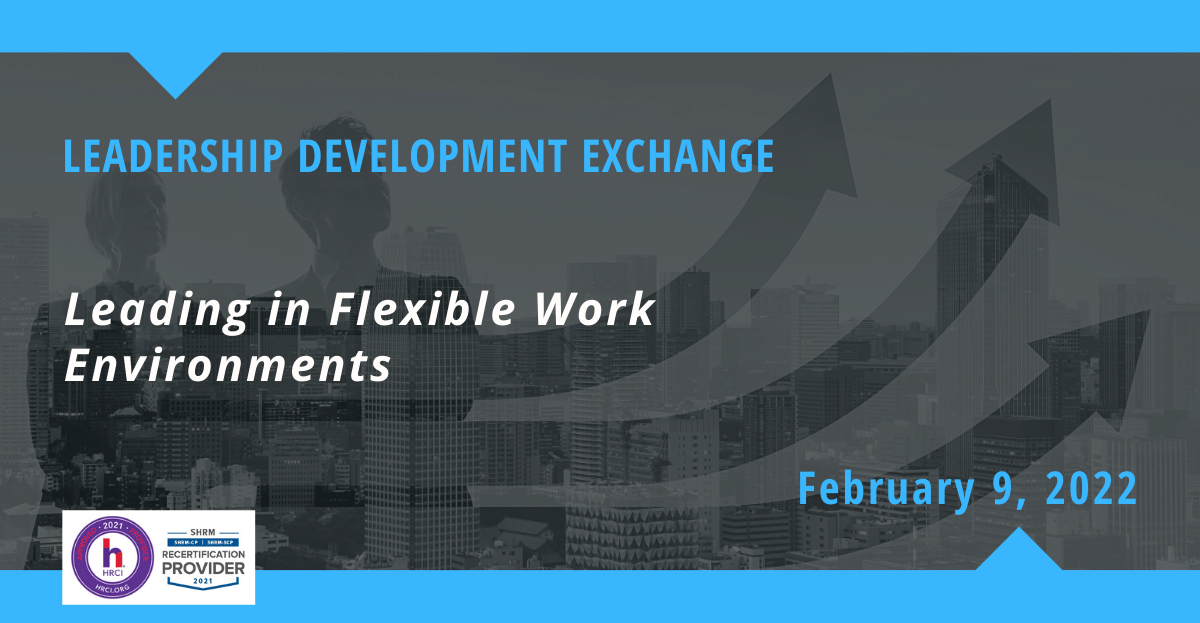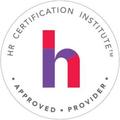
Leading in Flexible Work Environments
At our February meeting, our first of the year, we focused on leading in a flexible work environment and had a robust discussion about the development needs of leaders and managers to support workers equitably and effectively and navigate the complicated tradeoffs in these new work models.
The agenda for the day included:
- Welcome & Introductions
- Recent Data
- Attendee Poll
- Member-led Discussion I: What’s working in hybrid?
- Break out flexible work scenarios
- Member-led Discussion II: What’s difficult in hybrid?
- LDE 2022 Calendar & Announcements
You can access the jamboards from the breakout sessions here: https://jamboard.google.com/d/1KjxZBF6YxB5fDFCFoWp0Y4hb0a8hbnOFujlxqpucic0/viewer?f=0
You can also check out what books and podcasts your colleagues recommend:
https://jamboard.google.com/d/1VNV6YkkUyueD_nsg0B_9ruFRV5cL0jdgHZH-lA7EMGI/edit?usp=sharing
Senior Research Analyst Katheryn Brekken provided a sneak peek on i4cp’s upcoming research report, Flexibility or Flight: Hybrid Strategies to Attract and Retain Talent, which will be published at the end of the month. The study is based on the responses from approximately 1,200 HR and business leaders from over 70 countries around the globe. Navigating flexibility is new for most companies, and most managers and leaders alike need more information to lead successful teams in this rapidly changing environment. Katheryn provided data from those survey respondents representing companies with 1,000 or more employees who offered hybrid/remote only after the pandemic and planned to continue to expand hybrid remote positions. What are they doing?
- 73% of high performance organizations in this group are encouraging the development of team norms around how to effectively connect and collaborate, compared to 47% of low-performance organizations doing the same.
- 70% of high performance organizations are educating managers on how to engage employees no matter where they work compared to 53% of low-performance organizations. Moreover, this practice is correlated with market performance, a positive and inclusive work culture, leaders who embrace their current work model and organizations willing to adapt.
We then conducted a group poll: Which of the following cohorts will your organization focus foremost on developing in 2022?
- High potential employees
- Frontline leaders/managers
- Mid-level leaders
- Senior leaders
- Executive-level leaders (CEO direct reports)
- Don’t know
The largest group of respondents 46% said their organizations were focusing the largest proportion of their resources on front-line leaders, more than twice the number of those whose organizations were focusing foremost on midlevel leaders, followed by 9% who selected senior leaders.
Wendy noted that while her organization focused its leadership development efforts on all employees, they are in the middle of rolling out a new LD initiative. They finished a program focused on senior leaders last year and are moving to a front-line worker model in 2022.
i4cp Senior Research Analyst Tom Stone joined the call and discussed recent research on virtual classroom training. Things are never going back to the level of in-person training we had pre-pandemic. In person training will still play an important role, particularly for leadership development, but virtual training is here to stay. You can learn more here. I4cp will be publishing an update with best practices on modalities in the near future.
Next LDE leaders Paul Langlois, Vice President Enterprise Learning at Ecolab, Laura Payette, Sr. Talent & Development Manager at Microsoft, and Francois Raymond, Executive Talent Development Manager at Ford then led a discussion on the hybrid paradox and how leadership development is changing to support a working/hybrid work environment. One thing working well for Ecolab, due to the varied roles and responsibilities of its workforce, is establishing team norms, giving ownership to the team leaders, giving them guidance and helpful examples to think about as they talk with their teams about how they’re going to work, meet and communicate. “What works for the team is really up to the team,” Paul said.
Francois discussed the phenomenon of extreme users, individuals especially adept at leveraging social media and other remote work or instant communication tools. These extreme users then are able to mobilize teams effectively in this environment and as a result, their perspectives are also elevated and get traction. This is really changing the landscape of how leaders communicate with their teams.
Laura also stressed team norming and establishing open-feedback loops to understand what works and what does from multiple perspectives. The ability to communicate and clarify what those team norms are has been really important.
Kelly joined the conversation and discussed how the switch to remote leadership development, using a global curriculum has allowed employees to learn from leaders all over the world, increasing cross-cultural training, lowering costs for training, and bringing the entire company closer.
Participants were then distributed among three groups, or three separate flexible work scenarios established and led by the LDE leaders. You can access the notes from those meetings here.
Following the breakout groups, the LDE leaders led another discussion: What are the trade-offs of a flexible or hybrid work environment? What’s not working for leaders?
Francois noted there are tradeoffs and also a recognition of how much people can do at once. In his breakout group, they discussed with all the changes occurring its important to establish the norms. Is there understanding and acceptance as to how we are going to move the changes forward so everyone has a role in the change, feels valued, and can contribute.
One big issue in Paul’s breakout room, when you actually have those hybrid meetings how do you keep the side conversaitons from happening. We have all learned to raise our hands and speak in turn, in the hybrid meeting you actually have people raising their hands still, which allows us to collaborate in a more effective way. This will continue to be a challenge going forward.
From a Microsoft perspective, Laura indicated from the teams already experimenting with hybrid. Visitbility, being unequal, how do the folks not in the room get equal visibility? How do we make sure everyone’s voice is heard? Yes, we have learned to raise our hands, but how does that work when not everyone is in the room? How do we not talk over people? There are new norms to make this work and being aware of this dynamic. It is going to take practice and feedback. What do feedback loops look like at organizations? Are leaders giving feedback and are open to receiving feedback to improve intentional behaviors that ensure equity in hybrid environments? There is a risk as we return to more in-person assuming that everybody’s wellbeing is well and that we’re operating from the same place and the reality is we won’t be. We never were. How do we move forward and have space for that psychological safety? It’s going to take intention and continued care to help people be their more authentic selves.
Paul added that any kind of declaration or blanket statement will not work because every team is different, and this will require leaders to demonstrate flexibility.
Leaders need to understand that what works for them may not work for everyone and there’s an increased need for empathy and compassion and meet their employees where they are.
Jody emphasized the importance of recalibrating norms, expectations, and values from time to time.
Norms and expectations fluctuate, and we have to be ready to revisit them more, Francois added.
Katheryn added the need to be aware of what we don’t know. At the beginning of the pandemic, many leaders urged employees to keep cameras on during meetings to increase engagement and then research came out that such “camera on” policies can be harmful to employees close to burn out or struggling for other reasons.
Gwen responded that leaders should be cautioned against the idea that of ‘If I can’t see you then work isn’t happening.” It leads to over standardization and more stringent guidelines to prove that work is getting done. You have to figure out what the outcome is you want to see. In addition, she has talked to leadership about the use of cameras from a lens of psychological safety. When we talk about putting cameras on and being able to put your eyes on someone, there are a lot of things to notice: someone wearing the same clothes multiple days in a row, or someone who is acting in other ways that are unusual. The camera doesn’t have to be on in every situation but there are times, such as one-on-ones where it can be important. There are risks associated with freedom and flex and leaders need to be mindful of both.
The LDE meeting wrapped with a few more announcements. The next meeting is April 13 at 3 p.m. Eastern and will be focused on Listening & Leadership. If you have questions about this topic you’d like addressed, are passionate about it and want to lead a discussion or have a good idea about someone who should, please email your LDE Champion Nina Holtsberry and LDE researcher Katheryn Brekken at nina.holtsberry@i4cp.com and Katheryn.brekken@i4cp.com.
A robust discussion on leadership development in a flexible work environment with valuable insights from our exchange leaders Paul Langlois, Vice President Enterprise Learning at Ecolab, Laura Payette, Sr. Talent & Development Manager at Microsoft, and Francois Raymond, Executive Talent Development Manager at Ford and LDE members
log in

